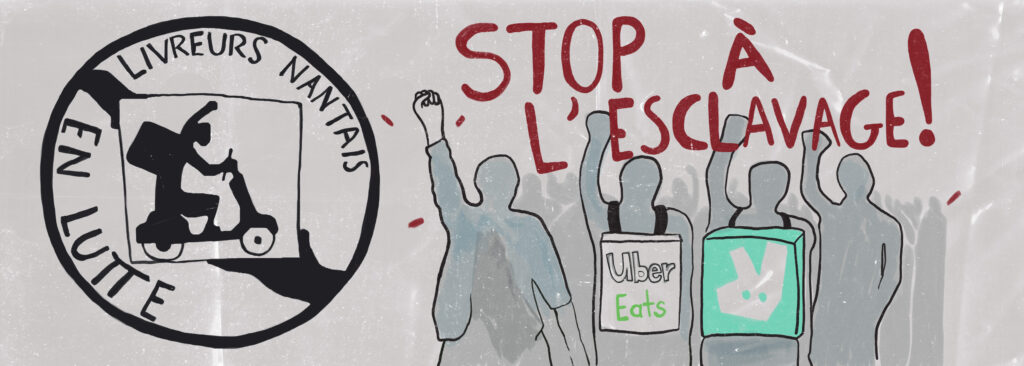…Masses of delivery riders continue to multiply on public thoroughfares, creating living hell for residents and restaurateurs…
Le Figaro, June 2021
It would be one of those times when years of change would unfold within weeks. Nowhere was this more evident than in France, the first nation in the European Union to be struck by covid.
In the same way as the 20th century arrived late, not fully emerging until 1914 as the shock of a World War forced a wave of change upon the world, the 21st century was to be a late riser, slumbering away for nearly two decades, until rudely shaken awake by a virus.
In France, the tremors would be felt across the economy, but for many in the food industry, the shake-up felt more like an earth-quake. The restaurant trade was caught in the firing line, as establishments across the country were cut off from their regulars by the successive lockdowns imposed to curb the contagion.
But in the crisis, lay opportunity. Making milk from the misery of the restaurateur were a multitude of players in the delivery business, which underwent a phenomenal boom.
From the major food tech platforms to businesses supplying couriers with their sets of wheels, right down to the lone micro-entrepreneur delivery rider, all were after a slice of the pie. But the road ahead was to have many twists and turns, and the one who appeared to be ahead begin with, was not necessarily so positioned at the end.
This is the story of the contest that played out on the streets of France during its turbulent ‘long year’ of covid, from early 2020 until mid-2021, as the virus-induced paralysis across the nation induced an upswing in demand for meal delivery. The particular focus is the delivery agents, who were on the battle lines of the war.
The year of gloom and boom
Through the lens of the French media, 2020 would be dominated by the coupled calamities of covid and confinement, a bleak year in which the shadow of pestilence cast a pall over France’s normally bustling urban centres. The pulse of the downtown traffic, once reliably regular, shifted to patterns more spasmodic, listless for most of the day, then swelling into a hectic hurry in the late afternoon as citizens rushed to beat the daily six o’clock covid-curfew.
As the clock ticked ever nearer to that inauspicious hour, the rapidly emptying streets became hushed, with only the door-slam of the homecoming straggler or the distant howl of the ambulance siren betraying the leaden atmosphere. But as the quietude set in, hints of motion indicated that some new hustle was afoot, and then, a strange dance would begin.
At the stroke of six, the silence of the streets would be broken by an unusual ballet. A procession of riders, adorned with bulging bags and borne aloft two-wheeled vehicles, emerged to begin their nightly routines, zipping across cities through dark and deserted streets.
Over the rollercoaster months of covid, these delivery riders and the restaurateurs they serviced were pushed into a desperate scramble for survival as the entire food industry of France was thrown into upheaval .
Restaurants, first abandoned by jittery customers as contagion spread, were then forced to shut-doors altogether by ever-extending lockdowns.
But while in-house dining was rendered moribund, the food delivery industry was booming. Dominating the field were the industry giants, Deliveroo and Uber Eats, riding the wave of desperation as legions of restaurateurs rushed to pivot their businesses from dine-in to delivery almost overnight.
In a country where many still clung to eating habits rooted in tradition, France had been marked as a growth market by the rival food-tech megalodons. Suddenly, with an entire population thrown into lockdown and with the cafes and bistros no-go zones, it was now, quite literally, a captive market.
But the stakes were high. For one of these two food-tech titans, this was a critical market, one which they would not willingly cede without a fight.
Gladiators on e-bikes
The nightly danse deux-roue that played out on the streets of French cities during the pandemic was seen in cities throughout Europe, but it was especially scandalous for many locals to watch the delivery boom pan out in the home of the Fifth Republic, a land where lunch is a sacrosanct ritual, and the desk-lunch forbidden, in principle if not always in practice. (1)
In France, as in Europe, the cohort of food delivery riders who formed the backbone of the covid-driven courier boom were composed largely of migrants and students, often itinerants forced into a permanent state of impermancy as a result of Europe’s stubbornly high rate of unemployment.
Most operated in a peculiar state of flux: In theory self-employed, they needed to register for autoentrepreneur (or microentrepreneur) status if they hoped to don the cooler-bag and emblazoned jacket of one of the major platforms, and in line with this free agent status, they bore responsibility for the purchase and upkeep of equipment required for the role.
All the while, the order-flow that was their bread-and-butter was doled out by the platform, their access to which could be, and sometimes was, cut off on the whim of an algorithm.
But while lacking in security, they were not lacking in spirit. Thrown into the deep-end, the livreurs of France proved their mettle, rising to the challenge in the most testing of times.
To begin with, their ride of choice was the e-bike. Packing more grunt than pure pedal-power, at the cost of just a few cents for each charge of the battery and requiring neither license nor insurance, the e-bike had become the established tool-of-the-trade for delivery riders on the eve of the pandemic.
The sobriquet ‘Gladiators on e-bikes’, coined by one reporter, was thus apt. Like sword and sandal warriors of an arena, the delivery riders of Europe found themselves thrust into a high-stakes contest on the streets, constantly juggling the not inconsiderable perils of the job, from dangerous drivers to the coughs of the contagious. (2)
And yet, unlike other more lauded essential workers, the efforts of the delivery rider were not always met with appreciation.
A tyranny of thumbs
As if the risks of traffic collision and viral exposure were not enough to contend with, the delivery rider was all too regularly faced with maltreatment while on the job.
When picking up orders, riders would sometimes have to suffer surly restaurateurs, demanding that they wait in the bitter cold and rain outside the establishment. At the other end of the run, disgruntled customers could let off steam, upset that their meal was late.
As one delivery rider commented, this only added to the woes of the riders:
‘Its stressful. And sometimes the customers talk badly to you because you’re late… you are forced to go fast, the customers pressure you’
– Youssef, Cherbourg delivery rider (3)
Given that many of the delivery riders were visibly of African background, the ‘bad’ words alluded to above not uncommonly included some with racist overtones.
Riders generally had little recourse in the face of such ill-treatment. Couriers were subject to appraisal by restaurateurs and customers, and lived in constant dread of the pouce rogue, the thumbs down. (4)
One mark-down too many could result in a courier being bumped from a platform, even though such spur-of-the-moment ratings could be prompted by circumstances well beyond the rider’s control. Stakeholders could also leave complaints about the rider, and these, as well as their overall satisfaction score, were readily accessible through the app, serving as constant reminders of the precariousness of their position.
But the biggest source of pressure on riders was measured not in harsh words, but in sparse Euros. The triad of lockdowns, surging French unemployment and aggressive recruitment by the two delivery giants resulted in an explosion in the numbers of delivery riders, ultimately leading to more competition for each order on the part of riders.
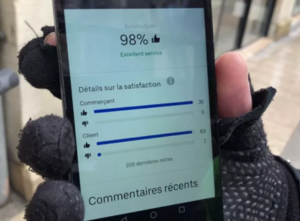
In July 2019, Deliveroo, one of the largest delivery platforms in France, stoked controversy when it moved to reduce the minimum cap per run of around five euros, prompting protests by delivery riders in many cities across France. (6)
These changes meant that many delivery runs were scarcely worth the effort for riders. In theory, riders were free to knock back these penny ante runs, but in the dog-eat-dog world of lockdown France, the competition could be so intense that some riders did not have a choice but to accept.
In the event, the timing of this change by Deliveroo could hardly have been worse. Within six months, the virus had spread its tendrils into France, and the resulting curfews and enforced shut-downs pushed thousands of the newly unemployed to take up the thermal-bag and bike, seeking out refuge in one of the few booming industries. Over the months ahead, many would be risking their lives for nickels and dimes.
Grind and hustle
Zooming down to the nitty-gritty of the street-level, the day-to-day stint of a delivery freelancer would commence once the rider had logged into the relevant app on their smartphone, which in France was usually that of one of the two dominant players, Deliveroo or Uber Eats.
From the riders perspective, distinguishing between these two platforms was largely considered much of a muchness, though Deliveroo, with its focus on independent restaurants, tended to offer a more varied and interesting range of deliveries.
So, while the Uber Eats courier might spend most of their day floating around McDonalds, the rider for Deliveroo could be delivering a Basque-inspired sheeps-cheese burger by Hélène Darroze or a lentil ragoût by Guy Savoy, both of which were available in Paris through Deliveroo during the pandemic. Perhaps more the exception than the norm, but it was an angle that the Deliveroo PR department were keen to promote.

That said, Uber Eats did have one drawcard. As a ‘free-logging’ platform, Uber Eats was the more flexible of the two, with Deliveroo requiring riders to book timeslots in advance. Riders weren’t under any obligation to choose between the two platforms, and indeed, many would ‘multi-platform’, alternating between one platform or the other on a whim.
It was vagary that could be exploited by the unscrupulous, and it wasn’t entirely unknown for riders to sub-let a spare account to a third party, often an undocumented migrant. (8)
Once logged into their respective platform, a canny rider would typically move to position themselves in a carefully chosen strategic spot, within easy reach of multiple popular eateries. Then, with eyes glued to their smartphone, a restless wait began for the first order.
A beep would signal the arrival of an order, with the value of the transaction on display for review. The rider had a short window in which to decide: 100 seconds for those with Deliveroo, while the unlucky Uber Eats rider was almost playing a game of snap, having no more than 30 seconds to accept. (9)
If the order was amenable, a quick tap would signal the acceptance of the rider, but, if the order failed to excite, the rider could opt to reject it instead. Once an order was accepted, the app would display a map highlighting the route to the restaurant supplying the meal.
Upon their arrival, the courier would show their smartphone screen to the restaurant staff as proof of the order, after which they would signal through the app that they had collected the meal, and a new map would appear, this time displaying the route to the customer’s address.
The rider again signalled their arrival once at the drop off point. Now, with the meal on the customer’s doorstep, the process began anew, and the rider would begin receiving orders once again.
Such was the humdrum routine of a typical day. From time to time, however, things could get a little more interesting.
Every so often, notifications would flash up on the rider’s smartphone, notifying of special bonuses that would be on offer for working in an impending timeframe. Uber Eats, for instance, had their quests, offering boosters to riders who delivered a certain number of orders: a typical example might read: ‘…Complete 3 additional runs to earn an extra € 7.50…’ Deliveroo offered similar incentives, if less creatively named. (10)
Uber aside, the words ‘quest challenge’ are scarcely encountered anywhere outside the domain of the computer-game, which presumably was the source of inspiration.
For the freelance delivery rider, the line between real life and the Nintendo could become somewhat blurred, with couriers becoming akin to real life version of the pixilated protagonist of the arcade game Paperboy.
But whereas in the retro 80s classic a joystick toting and button bashing human was in charge, for those engaged in the modern game of the delivery gig-hustle, the roles were reversed. It was a computer algorithm, constantly whirring away in the background, that was pulling their strings, control exerted not by means of a joystick, but through a range of monetary or dopamine-inducing incentives.
An algo called Frank
If you were to ask a Deliveroo rider who their boss was, they might nominate Will Shu, the CEO of the company as well as co-founder. But perhaps ‘Frank’ would be the more accurate answer. Frank was the algorithm that was adopted by the company in 2017.
Frank was new to the scene. The previous algorithm, Frank’s predecessor, was known as Louis. Louis was characterised by a certain concreteness in its modality, for example, it would allocate orders to riders based on their proximity to a restaurant. First in, first out. (11)
Operating in a cut-throat market, Deliveroo decided they needed a sharper edge, and so in 2017 the company embarked upon a transformation, adopting a cloud based data-warehouse to agglomerate the reams of info to meet the demands of the new model of data-hungry algorithm. (12) Experts were put to work engineer the new model, which was dubbed Frank. The end results impressed: Frank got the gig, and Louis, the guillotine.
Frank was an altogether different beast to its late forebear. In contrast to Louis’ one-track mind, Frank was deep, and to the unacquainted, even unfathomable. Underpinned by machine learning, the Frank algorithm was capable of factoring in a wide range of variables, including traffic data, the preparation times of meals, the day of the week, and even the weather.
The impact of the new algorithm became quickly apparent in every jurisdiction it was deployed. In France, for example, the average delivery time fell from 31 minutes under Louis to just 26 after Frank was adopted. (13)
The fortunes of each delivery rider were governed by this algorithm, even at the most basic level. If a group of riders happened to be equidistant from a restaurant that placed an order, the algorithm would churn through a swathe of inputs, and punch out the name of one rider for the job, with the specific logic behind the judgement often far from clear.
According to the company, the allocation process was entirely dispassionate, with the performance metrics of each rider being the only discriminatory variable factored into the equation. Seasoned riders, however, soon picked up that there were more ingredients in the mix than the company was letting on.
While awaiting orders, riders huddled outside of pizzerias and taco stands would chat, comparing notes as they passed the time. Bit by bit, these informal powwows would unpick the inner workings of the algorithm, and eventually, canny riders began to cognise that the law of Frank wasn’t quite the gilded meritocracy they’d been led to believe.
The weight of evidence, distilled from their numerous anecdotes, pointed to an inescapable rationale: that in the eyes of Frank, some sets of wheels were more equal than others.
Battle of the behemoths
In their race to dominate the French food delivery market, the focus of the two competing behemoths was squarely on the customers and restaurants, with the riders who did the actual work more an afterthought.
It was an all-or-nothing contest, where the prize was to build up a network of buyers and suppliers so vast that the platform became entrenched as the invariable go-to option, the large user base capturing ever more users by simple virtue of being big.
But it was also a highly territorial industry, and success in one region was no guarantee of success in another, even one close by. The dominant players in Germany, for example, were quite different from those across the border in France.
For this reason, major players would sometimes cede territory when it became apparent that the top-tier was out of reach. Deliveroo, for example, pulled out of Germany in 2019, when it became clear that they weren’t going to break through. (14) But while Germany may have been seen as expendable by Deliveroo, France was an altogether different story.
During the covid-crisis, the food delivery industry in France was a duopoly, with Uber Eats facing off against Deliveroo. The next largest player, Just Eats, was a distant third.
Uber Eats dominated the French market prior to the pandemic, with a 52% share of the market in early 2020, while Deliveroo, the pure-play delivery specialist, had carved out a 36% slice of the pie. By the start of 2021, Deliveroo’s share had jumped to 41%, on the back of an aggressive subscription drive.
It was a win that the company sorely needed. Deliveroo was on the road to an IPO and needed a positive story to tell if they wanted to keep their share price nice and high, post listing.
Uber Eats enjoyed a bit of an edge in the contest, thanks to established relationships with many of the major fast-food chains, such as McDonalds, (15) and so Deliveroo depended on signing up large numbers of independent restaurants. France, a land long renowned for its many fiercely independent restaurateurs, represented a fruitful patch for Deliveroo.
The large number of restaurants was not the only reason France was attractive to Deliveroo. The French delivery market was regarded as less mature than other major European markets, offering more scope for growth.
One estimate from 2017 indicated that of the 180,000 restaurants in France at that time, only 10,000 offered a delivery service. (16) In most French cities, pizza would seem to have been the only commonly home-delivered meal, with one survey finding that 26% of households had ordered a home-delivered pizza in 2019. But local tastes had not ventured much beyond pizza, and the next most popular type of home-delivered food, Chinese and Sushi, sat far below at just 10%. (17)
This low rate of home delivery was reflective of a French predilection for take-away over home-delivered food, especially beyond the capital. Citizens of smaller urban centres preferred to pop-in to their local when ordering a meal, exchanging a quick ‘bonjour’ and maintaining face-to-face contact with local establishments.
For Deliveroo, this cultural quirk represented an opportunity ripe for exploitation, and thus a chance to steal a march on its larger fast-food focused rival.
As 2019 ticked over to 2020, the rival giants were pondering their next move, eyeing each other off over a map of France, their strategic prize. Then, covid interjected.
With lockdowns and curfews implemented across the nation, what was already looking like a promising market became an El-Dorado. Home-delivery demand exploded, and what should have panned out as something akin to a choreographed contest between rival iron chefs devolved instead into a free-for-all.
It was a grab for territory, as much as in any conventional gold-rush, and the major players needed to stake their claim, and quickly. To that end, by the close of 2020, Uber Eats had recruited some 10,000 extra delivery riders across France, and Deliveroo, over 4,000. (18)
As armies of delivery riders flooded onto the rues and boulevards across France, the consequences were not entirely surprising. One Paris-based rider curtly described the situation in early 2021:
‘It has become the wild west’
– Antoine, Paris delivery rider (19)
The Three-sided market
The rapid emergence of the Deliveroo-Uber Eats duopoly in France is peculiar given that France spawned one of the pioneers of the food-tech segment, Allo Resto. This home-grown platform, founded in 1998, was in operation for over fifteen years, and in contrast to Deliveroo and Uber Eats, was comfortably in the black for most of its years of operation.
And yet today, the turquoise livery of Deliveroo furnishes every street corner in Paris, whereas Allo Resto is but a fond memory.
Why was it that the profitable Allo Resto faltered, fading into insignificance, leaving Deliveroo to dominate?
What distinguished Deliveroo from the food-tech groups of the dot-com era was that it was underpinned by a new model, known in the industry as the three-way marketplace. Deliveroo would be the first to build an effective platform based on this model specific to meal-delivery.
Allo Resto operated on the 90s era food delivery model, wherein they would provide the web infrastructure for a restaurant partner (including, in its last years of operation, an app), but the scut-work of delivering the food to the customer remained in the domain of the restaurateur. Effectively, it was a two-sided market, with Allo Resto pairing with individual restaurants.
Deliveroo, however, added another string to the bow. They provided not only the online infrastructure, but also brought their own logistics network to the table. This was the bones of their three-sided model, where restaurants would connect with riders, and riders with hungry consumers.
Restaurants that were unwilling or just too small to manage deliveries represented an untapped market, and in France, there were loads of them. Around the time that Deliveroo set up shop in the country, less than 10% of restaurants offered a food delivery service. (20) Allo Resto had been swimming in a pond, while Deliveroo was jumping into a lake.
A comparison of the growth-path of the native with that of the newcomer starkly illustrates the advantage of the multi-sided model over the vanilla prototype. Just prior to being subsumed into Just Eats, its largest stakeholder, in 2018, Allo Resto had registered some 4,000 restaurants across France. (21)
Two years later, Deliveroo, despite only having made landfall in France in 2015, had managed to sign up 12,000 partner restaurants across the country, and this even before the charged-up growth of the delivery segment during the years of the pandemic.
Deliveroo’s three-way model helped to drive its stellar growth, but the model owed its viability to a couple of innovations that emerged in the early years of the 21st century. The first of these was the smartphone app.
Deliveroo emerged fifteen years after Allo Resto, just as the internet was migrating from the desktop to the hip-pocket, thanks to the smartphone.
The smartphone app was central to Deliveroo’s success. The widespread adoption of the smartphone heralded the age of the omnipresent internet. Naturally, this bolstered online food delivery demand: near instantaneous orders could now be placed from almost anywhere, on a whim. Food at your fingertips.
But all the while, the smartphone itself was evolving at a rapid clip, its shape and design influenced by the growing popularity of mobile applications. The device became so handy, you could even operate one while riding a bike.
This leads us to a second, often overlooked technology that was to power Deliveroo’s growth: The e-bike.
Rise of the e-bike
On the eve of the pandemic, it was more likely than not that any given meal delivered by a French livreur was propelled to its destination with the aid of a 250 watt motor. In France, as in most EU jurisdictions, this marked the power-cap for a street-legal e-bike, known locally by the acronym VAE (velo à assistance électrique). Anything beyond the 250 mark was classed as a cyclomoteur and subject to registration and insurance requirements in the manner of a motorcycle.
The electric bike is no newfangled contraption, and probably is as old as the automobile itself. Perhaps the world’s first workable motor vehicle, unveiled on the streets of Paris by inventor Gustave Trouvé in 1881, was to all intents and purposes a kind of electric bike (or technically, a trike).
Despite its early debut on city streets, throughout the 20th century the electric bike failed to spark popular appeal, its riders remaining a rare and odd sight, belaboured by the ungainly ballast of the lead-acid battery and left struggling on the wayside.
But about the turn of the century, the winds of change began to blow, and the e-bike would soon find its place in the sun.
This change was induced by a couple of novel technologies, one of which was the lithium-ion battery, successfully commercialised by Sony in the 1990s, and widely available by the year 2000.
Prior to the advent of lithium-ion, most electric bikes were powered by bulky lead-acid batteries, as indeed was the Trouvé tricycle of 1881.
Lithium batteries packed more power-per kilogram than their lead-acid forerunners, with the new battery typically weighing in at less than half the original, and so an electric bike fitted with the new li-ion battery was more manageable and manoeuvrable. (22)
But in addition to jettisoning kilos of lead from the electric bike, the lithium battery also had a substantially longer lifespan. It was an entirely different class of machine, but even so, its success was not guaranteed. The enthusiasm of a few niche bike enthusiasts would not be enough to cement its place on city streets.
Still a fringe product in the early years of the millennium, the e-bike 2.0 was largely sold through small dealers via online channels, a backdrop that allured the unscrupulous. Tainted by a perception that it was a haven for ‘fly-by-nighters’, for several years the industry was stumbling around in circles, caught in no-mans land.
The breakthrough year was 2010, and the savoir was the mobile app. Growing on the back of the success of the iPhone a few years earlier, by 2010 the three-letter abbreviation had attained such widespread currency that it was crowned the word of the year. (23) The following decade would be characterised by app-ubiquity.
A year earlier, Grubhub was among the first to launch a mobile app in the food delivery space, and it took off like wildfire. (24) In 2010, Ubercab was launched in San Francisco, soon to be abbreviated to Uber (25). Postmates, the first app to employ a simplified three-sided marketplace model, was launched in 2011. (26) Two years later, Deliveroo enhanced the same model for meal delivery, integrating the restaurant partners as well as the gig-workers employed as intermediaries between the restaurants and consumers. Uber launched Uber Eats on the same lines in 2014.
Suddenly, the lithium-ion e-bike had its raison d’etre. The new lean, green machines proved to be a perfect adjunct to the couriers trade, and the growing ranks of food delivery couriers working for the major platforms would provide a steady customer base for e-bike dealers.
E-bikes offered a distinct edge over pure-pedal power. The boost from the 250 watt motor was noticeable, roughly equivalent to having an extra pair of legs. The benefit of the e-bike over the classic bike would have been obvious even to the most inattentive rider. They were able to complete more runs over a given period of time, and when time equals money, the net result is more money in the bank.
It was the app, or more specifically the food-delivery app, that brought the lithium-ion e-bike out of the shadows and into the mainstream. E-bike dealers were able to thrive and build up reputations, in some cases even migrating from the internet to bricks-and-mortar storefronts.
Vélorution electrique
France, with its strong cycling culture, was a natural market for e-bikes, and the sales figures from this country illustrate the hand-in-glove relationship between app and e-bike.
In 2007- the year the iPhone was launched- less than 10,000 VAE units were sold in France. But as the popularity of the app exploded over the next few years, it fed through to increasing sales of electric bikes in France, with the number of units sold per annum jumping by nearly 300% between 2007 and 2010. But impressive as this was, this was just phase one.
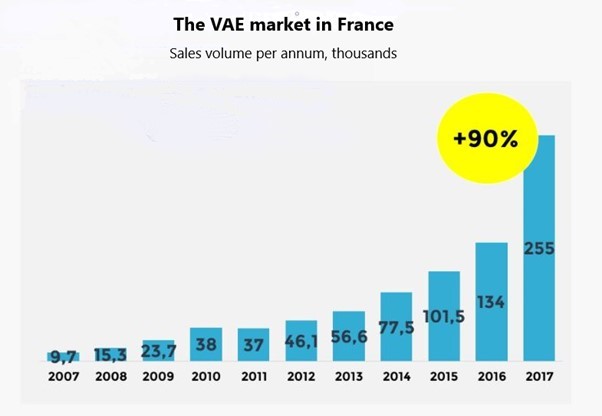
The second growth phase followed the arrival of the Deliveroo/Uber Eats duopoly in France. Deliveroo commenced its French operations in 2015, and Uber Eats launched in Paris in 2016, (27) spreading to more than twenty other French cities by the end of the following year (28). The arrival of these two platforms was to spur a phenomenal surge in demand of e-bikes, with the number of units sold jumping by 90% in 2017 alone (above).
The surge in demand electrified the entire VAE ecosystem in France, leading to a wave of entrepreneurialism at the tail end of the decade. The e-bike rental startup Velyvelo was founded in 2017; the snazzy e-bike company Vélo Mad was founded in 2018; and then, in 2019, there was Teebike, a French start-up which would, quite literally, re-invent the wheel, condensing the e-bike down to a boxable seven kilo wheel. (29)
The food delivery platforms were crucial to the rise of the e-bike, but it was a two-way street: they also benefited from it. The viability of the food-delivery apps relied on being able to access a large pool of delivery riders, and this was greatly assisted by the rise of the e-bike 2.0.
Of course, bike couriers existed long before the e-bike became mainstream. But their numbers were limited by barriers to entry. Motorcycle couriers required a license, and while this wasn’t the case for a bicycle, the gruelling work of the pedal-powered bicycle courier required both fitness as well as an abundance of ‘true grit’, not possessed by everyone.
Electric bikes took some of the sweat out of courier work, and the emergence of the e-bike meant that the platforms such as Deliveroo were now able to tap an almost bottomless pool of freelancers.
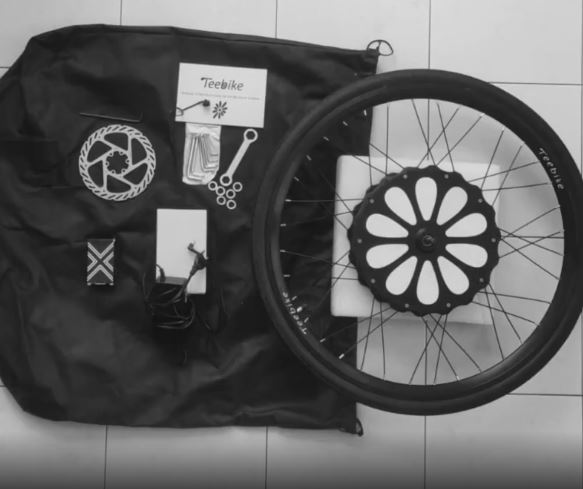
The war on the streets
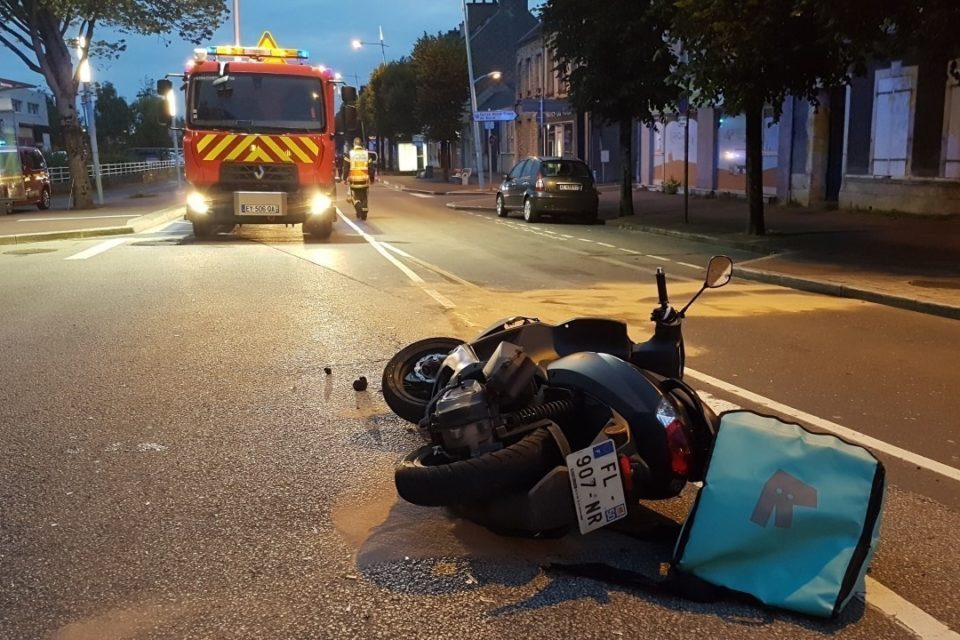
In August of 2019, Livreurs throughout France took to the streets to protest. The trigger was an email, sent by Deliveroo to all its rider partners on the 29th of July to notify of an impending tweak to its pricing model. Starting from August, the company would scrap the floor price for a run, which had previously been fixed at just below five euros. (30) Under the new model, some runs could be worth as little as two to three Euros.
Some riders concocted a mobilisation plan aimed at pressuring Deliveroo to drop the new pricing mechanism, but the resistance eventually petered out. (31) With the French unemployment rate above 8%, Deliveroo held the trump. In such a precarious jobs market, there were always going to be riders desperate enough to take the scraps on offer. Few could have believed that conditions could have got much worse, and yet they did.
The new year ushered in the twin calamities of covid and confinement, shaking up the food industry and turbocharging the war on the streets between Deliveroo and Uber Eats.
To term it a war is not too much of an indulgence in hyperbole. The grim toll from the contest was left strewn across the roads of France, with reports of the accidents that caused the carnage periodically peppering the newsfeed of regional media sites in France.
it is impossible to gage a clear picture as to the extent of on-the-job casualties of riders working for the platforms, due to the amorphous nature of their ‘gig-worker’ employment status. However, casualties there were, as is in abundant evidence from the litany of media reports from across France that together serve as the only real register of such incidents over the course of the pandemic.
18 May 2020: A Deliveroo rider on a scooter is seriously injured after being struck by a car in Nantes. (32)
10 June 2020: A Uber Eats rider, seriously injured in Dijon after being hit by a utility. (33)
7 July 2020: In Cherbourg, a rider for Deliveroo is taken to hospital in a serious condition after a hit-and-run incident. (34)
10 September 2020: A Uber Eats rider is killed in Clamart, after falling from his scooter and into the path of an oncoming motorcycle. (35)
6 November 2020: A rider for Uber Ears in Montpellier is struck by a car, thrown some thirty metres by the force of the impact, and left for dead on the road. (36)
5 February 2021: A rider, believed to a Uber Eats courier, left seriously injured after being struck by a tram in Reims. (37)
20 March 2021: A Deliveroo rider in Villeurbanne, killed after running into an oncoming car. (38)
22 March 2021: A Deliveroo rider in Lille is injured after being struck by a car. (39)
24 March 2021: A Uber Eats rider in Brest, left in hospital for two months after a traffic accident. (40)
4 May 2021: A Uber Eats rider in Paris, killed after being struck by a truck. (41)
6 May 2021: Another Uber Eats rider, this time in Sotteville-les-Rouen, is thrown from his bike after being hit by a car. He dies at the scene. (42)
Such reports, the only public record of the on-the-job casualties, bear testimony to the very real dangers of the livreurs trade.
It should be noted that accidents did not represent the only physical danger to riders. Omitted here are the reports of assaults of couriers, which seems to have been a disturbingly frequent occurrence in France during the pandemic. (43)
Delivery riders who had been on the job for an extended stint usually knew at least one colleague who had been seriously injured or killed on the job, and some knew more, as was the case with Kévin, a sort of vagabond delivery rider, who regularly moved between cities in the south of France:
In two years, two colleagues have died in Montpellier
-Kévin, roving Deliver Rider (44)
Kevin’s experience was probably unusual, but there can be little doubt that many serious incidents involving freelancer riders were not reported. One French study determined that as many as one in four delivery riders reported suffering an accident in the course of their work. (45)
Given the sheer numbers of riders on the roads- some 40,000 registered with Uber Eats and another 14,000 with Deliveroo by the end of 2020- the incidents reported by the media were surely just the tip of the iceberg. (46) In many cases, the ‘walking wounded’ at the scene of a traffic accident would just pick themselves up and manage their injuries as best they could.
Finally, we should not overlook the elephant: covid. Delivery riders in this period were working on the front-line during a pandemic, and in a country which would rack up the highest number of covid-cases in the EU. The number of riders who wound up with covid-infections as a consequence of their higher-exposure work on the front lines will likely remain in the realm of the great unknown.
This brings to attention the real sleight-of-hand by the delivery giants. While media stories about the bike-riding gig-worker tended to fixate on their miserly in-hand pay, the real scrimp was in the less tangible form of insurance provision, or the inadequacy thereof.
Although in 2017 both Deliveroo and Uber Eats offered to cover all riders working through their platform for accidents that took place on the job, these insurance payments were one-off and capped.
For an accident that resulted in permanent incapacity to a rider, the ceiling was 50,000 Euros, (47) notwithstanding the fact that the work of the delivery courier ranked amongst the most accident-prone of all occupations. (48)
Race to the bottom
Unbeknownst to the livreurs attending protests across France in August of 2019, the cause of their grief had been hatched a month earlier on the far side of the Chunnel, in the downtown London office by the Thames that served as Deliveroo’s global operations hub.
Frank, Deliveroo’s algo-in-chief, had spent its two years inside pouring over the millions of delivery runs that had taken place since it began, calculating the delivery times of couriers on bicycles, motorcycles and cars. After chewing through reams of data, Frank had arrived at a computation.
Frank’s determination became clear to riders in the United Kingdom in early July. In an email to the riders, the company noted that it would be tweaking their algorithm to prioritise motorised couriers over those on bicycles, except for in a handful of high-density downtown locations.
A new hierarchy of wheels was to be ushered in. Riders on motorbikes and motor scooters would now find themselves placed at the front of the order queue. E-bike riders were the next in line, with the unlucky push-bike couriers left at the bottom of the pile, to pick through the scraps.
The new pricing regime that the French delivery riders so stridently inveighed against that August represented Frank’s plan being put into action. The removal of the floor charge for each delivery was a rather blunt attempt to induce riders to adopt speedier vehicles, for while the tweaked algorithm jettisoned the minimum fee per run, it also boosted the fee for deliveries over longer distances.
The new formulae for pricing reflected a new strategy. Deliveroo was entering a new growth phase, moving away from geographies characterised by high population densities, such as England, and into landscapes with a more diffused population, as in greater France, beyond the Regione Parisienne.
Frank’s not-so-gentle nudge eventually had the desired effect. The removal of the floor fee for a run in 2019, followed up the next year by the flood of new riders on the streets meant that just eking out a living via means of the classic bicycle had become a Herculean labour.
Many delivery riders were to work this out through bitter first hand experience. Riders across France eventually got the hint, however, and one-by-one, they started to upgrade to more powerful sets of wheels.
The experience of one former bicycle delivery rider in Rennes, was typical:
I started this work in 2017. In the beginning, I delivered by bike. The more the delivery charges fell, the more we sought ways to go faster to compensate. That’s why I took to the scooter. It allows you to do more while being less tired.
Meal delivery is my full time job. 61 hours per week. In two years, I lost 40% of income with their price reductions
-Mickaël, Rennes delivery rider (49)
To the south, in the city of Toulouse, another rider described to a reporter how he opted for exactly the same course of action, ditching the bike for the scooter, explaining the calculus behind the decision:
We have to take longer and longer delivery runs and the most efficient way is still the scooter. By bike, with the adjustments to pricing, I lost 30% of my turnover. On a scooter, I lose less money. Factoring in petrol and insurance I earn 5 to 10% less. I am between 2000 and 2500 euros for 50 or even 60 hours a week.
– Sébastien, Toulouse delivery rider (50)
And again, we hear the same story in the North. A Rouen rider described how the local livreurs had all but deserted the bicycle:
There is hardly anyone on the bike anymore. We have to go faster and faster, we need to be on a scooter…
-Aboubakar, Rouen delivery rider (51)
West, North, South…It was happening across all quadrants. As the lockdowns wore on across France, and weeks transformed into months, the e-bike’s elegant evening dance was steadily replaced by swarms of screaming scooters.
The consequences were not entirely unpredictable, though not foreseen by Frank. The laws of unintended consequences fell beyond its remit.
Flambées
It wasn’t long before the incessant din of the delivery scooteriste began to attract unwanted attention. Things were to first come to a head in the south, in the city of Montpellier.
The stage for the impending showdown would be the Écusson, the historic heart of the city, a matrix of plazas and narrow, winding streets, but also a natural magnet for delivery riders as the area was thronging with vendors of tasty snacks. Although the old quarter was designated a pedestrian zone, in the wake of the second period of curfew starting from October 2020, the area had become mostly desolate.
Scooter-borne delivery riders, pressured for time and seeing a clear run ahead, got into the habit of cutting across the plazas to pick up orders, as had already been the established practice for bicycle couriers.
This constant stream of scooters generated noise, and the noise soon generated a stream of complaints from those living in the apartments above. As December drew to a close, the Mayor of Montpellier decided to act, determining that his New Year’s Resolution for 2021 would be a scooter-free Écusson.
In the chilly early hours of the Saturday that followed on from New Years Day, scores of delivery riders, lured by expectations of a strong order-flow from the festive mood and the cold weather, descended on the Écusson.
It was a trap. The police were waiting for them, and embarked on a ticketing spree, slapping fines on no less than 18 scooter riders within an hour, all but one of whom were garbed in the colours of Deliveroo or Uber Eats.
The second flash-point would be in Nantes, the capital of the west. Once again, the controversy centred on the old part of the city, known as the Nantes piétonne, a labyrinth of narrow streets crammed with a hundred or so cafes and restaurants, just to the north of the river-island that was the hub of the city.
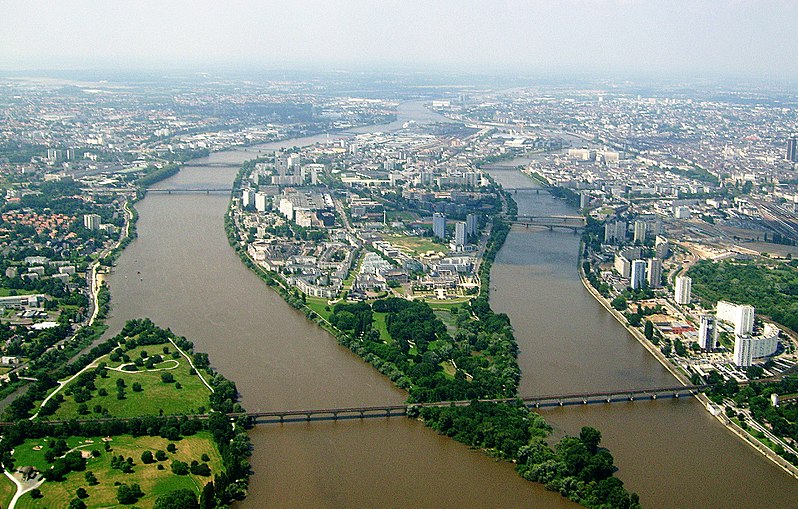
Livreurs scooting down the cobbled streets of the old city had become an increasingly common sight in the area since the initial lockdown period, their two-wheelers darting in and out to pick up packaged meals and ferrying them to the confinement-captives around town. When the lockdown émancipées finally spilled out on to the streets in June, it wasn’t long before the two groups bumped heads, occasionally, quite literally.
In June 2020, two elderly women were knocked over in the centre of Nantes by a careless delivery rider on a bicycle. Complaints also began to mount in relation to the cacophony created by the numerous scooter-riding couriers, whose numbers had been compounding at an alarming rate since the start of the year.
In response to the growing complaints, the city stepped up policing of delivery riders, but this would prove to be just the first volley. (52)
Early in the new year, a few days after the crackdown in Montpellier, the Nantes town hall decreed that from the 8th of March, the movement of internal combustion engine scooters through the piétonne would be restricted to a narrow window in the morning. Electric scooters were largely exempt. (53)
The disquiet was not confined to regional cities. In Paris, too, complaints were rising, although here the discontent was centred around activity at the site of Deliveroo’s very first ‘dark kitchen’ in France, the busy Editions site in the northern suburb of Saint-Ouen.
The site was a hive of activity throughout the pandemic, a constant stream of scooters roaring out of the parking bay gates as an assembly-line of meals were churned out of the industrial kitchens to sate the surge in demand for home-delivered meals. Unsurprisingly, the site wasn’t especially popular with residents living in the apartment just across the road. (54)
Attracting complaints, and unwanted French TV cameras,(55) Deliveroo, in consultation with the local elected representatives came to arrangement: those riding on conventional scooters would park in a designated space some fifty metres down the end of the street, and the on site parking-bay would be only accessible by electric scooters and bicycles.
Deliveroo subsequently implemented a rental scheme to encourage their delivery riders to make the shift to electric, and established recharge terminals at the French Editions locations. (56)
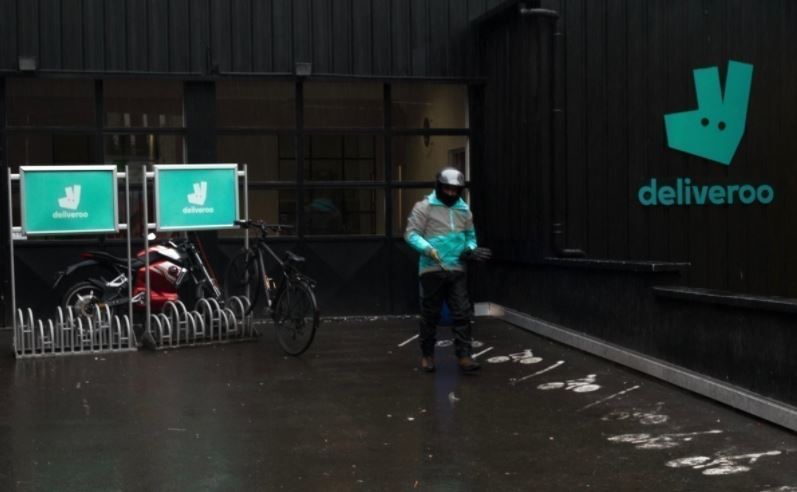
The situation in Nantes was not to meet with a neat resolution as in Saint-Ouen, and the dispute between the town hall and the delivery riders would to continue to drag out over the months ahead.
Springtime of the Livreurs
In Nantes, the prohibition of scooters from the city centre would hit a raw nerve. The Nantes piétonne covered some twenty hectares of inner-city real estate, and picking up an order from a restaurant in the heart of the area would necessitate a delivery rider dismount and dash hundreds of metres across the forbidden zone, sometimes laden with several kilos of food and beverages on the way back, all the while leaving their vehicle unattended.
One aspect that made the issue all the more incendiary was that most of the 500 or so Nantes couriers operated through the Deliveroo platform. (58) Many would have been swayed to invest in a scooter after having taken the hint from their algo-boss Frank, who had elevated motorized two-wheelers to the top of the algorithm totem-pole some eighteen months earlier.
In the days after the ban was enacted, several scooter-riding delivery riders were slugged with hefty fines, spurring the delivery riders to take a stand. Fed up with the police harassment, fines they could ill-afford, and the latest imposition in the piétonne, they began a mobilisation action. (59)
In early April, a meeting with town hall officials by a delegation of riders aimed at nutting out a compromise proved fruitless, and so the next week they took to the streets, initiating their own impromptu press conference in the town square.
In the fresh spring-time air, the riders assembled in the heart of Nantes, their banners prominently displayed behind them. The ruckus did not fail to attract ample media attention, as well as that of the local constabulary, who at one stage attempted to take down their colourful banners.

The ban in the pedestrian zone curtailed their already parsimonious daily earnings, as one rider related to the waiting media:
Before the March 8 decision, I was earning 70 to 100 euros a day. Now I can’t make 50 euros a day
-Mustafa, Nantes delivery rider (60)
The riders also called on the town hall to designate more parking spots for delivery riders in the vicinity of the piétonne, and for a hand-out to help them upgrade, for, as they pointed out, the cost of an electric scooter was prohibitively expensive, 3-4,000 Euros, certainly beyond the reach of those earning 50 Euros a day, and this before expenses. (61)
Notwithstanding the protests, the Nantes town hall, like that of Montpellier, were not willing to compromise, and the scooter riding livreurs were eventually pushed out of the old quarters of the city.
A strange way, it would seem, to treat workers who were ultimately providing an essential service, delivering food to those who were unwilling or unable to collect it themselves.
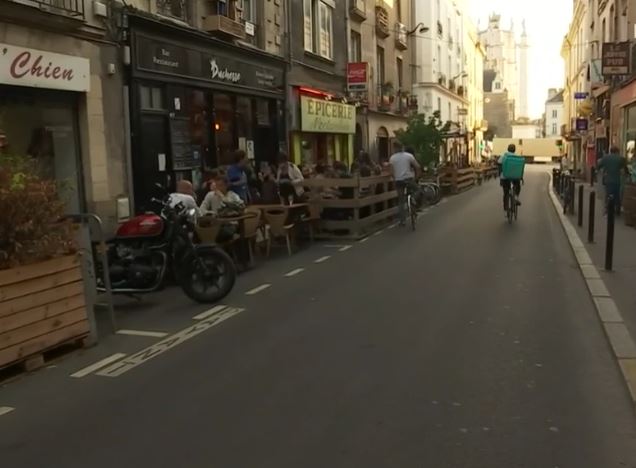
Livreurs versus Les Bobos
Why was it that these erstwhile essential workers singled out for such disrespectful treatment by the town hall?
Certainly, some of the complaints relating to delivery riders in the city-centre were justified, with some reckless operators endangering pedestrians. It is interesting to note, however, that the accident involving the two women in June was the result of a collision with a bicycle-courier, rather than a scooter. It would seem the noise complaints were of greater priority to the city than the safety concerns.
At any cost, electric scooters were mostly exempt from the movement restrictions that were imposed in the piétonne.
It is difficult to entirely shake a suspicion that there was an element of politics in the dispute between the delivery riders and the city. Even at a glance, it was obvious that the two sides at loggerheads were a gulf apart.
The disgruntled citizens were mostly property-owning, educated inner-city types- a group who typify the pejorative label Les Bobos– and, as largely white-collar workers, most were working from home during the pandemic, and so fully exposed to the blare of the passing scooters. The delivery riders scooting past their windows, on the other hand, were independent workers, who tended to be younger, and with lower levels of education. Perhaps in essence a clash between the bourgeoise and an emerging class of micro-entrepreneurs?
And yet, there was another facet to this dispute, one simmering below the surface. It could not have escaped attention of locals that the majority of the delivery riders operating in Nantes during the baleful years of the pandemic were not white.
There was a widespread suspicion that any delivery rider of African appearance was liable to be one of the sans-papiers, the French term for undocumented migrants. The flames of this animosity were inadvertently fanned by the disproportionate media attention given to the underhand practices of the major platforms.
There certainly was a problem with illegal subletting of accounts, facilitated by social media, and without doubt, some undocumented migrants were working through these during the pandemic.
But in general, the assumption that the ranks of the livreurs were replete with covert workers was mostly incorrect. The daily routine of the delivery rider placed them in the full glare of the public, and riders were often targeted for checks by police.
Uber Eats, the largest platform in France, also had measures in place to counteract the problem. Periodically, riders working through the app were directed to take a selfie, to verify the identity of the account holder.
The ranks of the delivery riders was thus hardly the ideal safe-haven for he who wished to evade detection. Even so, given the high rate of unemployment in France, the issue of undocumented workers was inevitably a political hot-potato, and the perception that Deliveroo and Uber Eats were facilitating clandestine work was widespread.(62)
The beleaguered delivery riders of Nantes, like those of Montpellier, were thus caught up in a riptide of political cross-currents. Inner city residents perceived them as a nuisance, while other sections of the community, mostly less affluent, viewed the riders as undesirable aliens, possibly even as criminals. The unfortunate livreur was a political piggy in the middle, seen as expendable by the town hall.
The controversies at Nantes and Montpellier were microcosms of a broader tensions across France. The major delivery platforms were widely despised across the country, with passions particularly intense in regional areas. In the public relations war, it was clear that the likes of Deliveroo were facing an uphill slog.
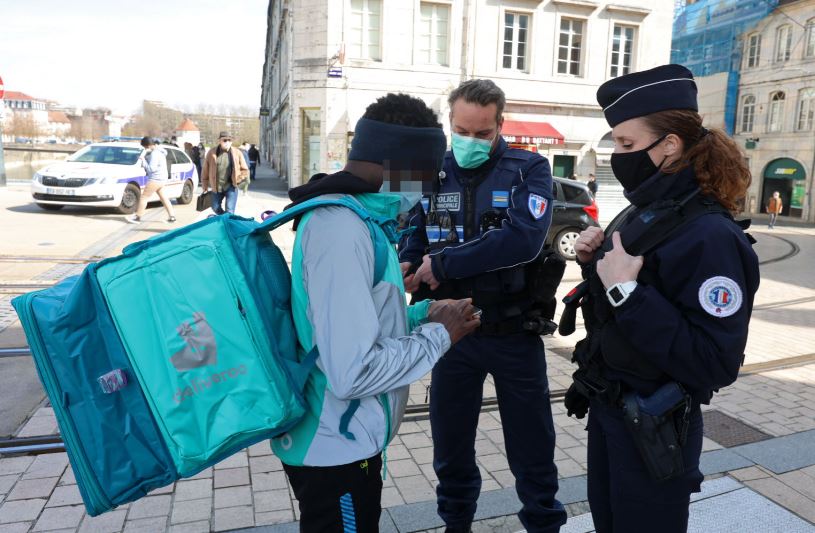
Is France Deliveroo’s Waterloo?
Touted as the London Stock Exchange’s great post-Brexit hope, Deliveroo was rung on to the LSE on the 31st of March, 2021, (64) through a remote and era-appropriate, pre-recorded, covid-safe ceremony.
That day, holders of the newly-minted shares had for once more to worry about than covid. The share price slumped, ending the day 26% below the offer price of £3.90 per share, and the sombre mood of the day would be encapsulated when one of company’s bankers described the affair as ‘the worst IPO in London’s history’. (65)
In the months that followed, the Deliveroo share price vacillated, falling as low as £2.28 in April, before staging something of a recovery, heading north for several months, at one point even briefly managing to clear the initial offer price. But then, the rally ran out of puff. The initial offer price of £3.90 had become a ceiling.
In the wake of the dismal debut, sideline-wisdom gushed freely across the interweb, with online sages gathering round to observe the wreckage and to offer up post-facto insights into the causes of the crash.
Commonly, such critics cited the dual class share structure, with Silicon Valley-style class B shares giving CEO Will Shu influence over voting resolutions; the poor timing, with the IPO being unveiled before the release of the first quarterly update; still others simply pointed to the lack of profitability of the company.
Yet, in many respects, the Deliveroo flop was counter intuitive. In the middle of a stock boom in an age of cheap money, when yet-to-be-lifted lockdown restrictions were dragooning Britons onto the platforms, a delivery company with a recognised brand should surely have had it in the cubic kangaroo bag.
However, there is no doubt that one running concern did indeed serve to act as an anchor on the Deliveroo share-price on that fateful day, and it was an ail that was as clear-as-day, even flagged in the Deliveroo prospectus: the lingering controversy around the delivery riders who worked for the platform. (66)
The Achilles heel of the IPO was that the most visible of the three walls that held up the house of Deliveroo also happened to be the most contentious aspect of the business. Some listed companies attempt to keep their less savoury operations hidden away in overseas sweatshops, but the dirty laundry of Deliveroo was on full parade on city streets every evening.
The gig-worker controversy was the largest of the millstones that weighed down the IPO, albeit one that was flagged by the company. However, Deliveroo was less forthcoming about another substantive risk factor.
The Deliveroo prospectus document contains an impressive-looking list of markets that the company operates in, with no less than a dozen countries named, spread across three continents. (67)
But looks can deceive, and so it is with Deliveroo’s earnings, which are far less diversified than they appear at first glance.

The chart above depicts the relative size of each of the markets Deliveroo operates in, based on the list in the prospectus. Deliveroo exited the Spanish market, its fourth largest, in July, leaving eleven remaining.
It is striking that only two of these markets, France and Italy, are in anyway comparable to the size of Deliveroo’s home market in the United Kingdom, and Italy is very much the poor cousin of the three, being less populous, occupying a lower rung on the income scale, and a more mature home delivery market to boot.
Deliveroo does not provide specific details in relation to the earnings breakdown of each region in their announcements, however in their August 2021 presentation, the company boasted of 137,000 restaurant partners globally as well as nearly 10,000 grocery partners. (69)
Based on local sources, it would seem that 20,000 of these restaurant partners are in France, (70) with just over 14,000 in Italy. (71) With just over half, or around 75,000 of these partners were in the United Kingdom and Ireland, that would point to some three-quarters of the 146,000 odd partner restaurants being concentrated in just three countries.
And 30% of their delivery partners beyond the British Isles were located in the country just a hop and a jump across the English channel. Deliveroo, priced as a growth stock, was excessively exposed to this one market, France.
Deliveroo’s growth hinges very much on how things pan out in France. It is the only European country of a comparable size to Deliveroo’s home market of Britain, and yet the jejune French delivery market lags well behind that of its island neighbour.
As was noted in the prospectus, the United Kingdom and Ireland accounted for 50.3% of the company Gross Transactional Value (72). But whereas Deliveroo has 50,000 riders operating across the United Kingdom, there are only 14,000 of them across France. Quite literally, the Deliveroo growth story has got a lot riding on France.
But the portents from that country are not promising. A sweep of the coverage on delivery platforms by the French media highlights the problem.
Over the course of the pandemic, one word recurs in the French media reports on the topic of delivery rider autoentrepreneurs, and it is the same word that was displayed so prominently on the banner of the Nantes delivery riders: Esclavage.
This is reflective of a widespread perception of freelance delivery riders as modern-day slaves, a view which is all the more poignant given that many French delivery riders are of African background.
The French media is not alone in running with this theme. Breathless reportage focused on the poor conditions of gig-working riders of the platforms has become standard fare for mastheads across the western world. But what is unusual about France is that the issue seems to cross political boundaries, raising passions at both ends.
At one end of the political spectrum, Deliveroo and Uber Eats are equated with modern-day slavers and exploiters of the vulnerable. On the polar opposite, the platforms are detested for supposedly providing a haven for undocumented migrants.
It is worth noting that, in a response to the woes highlighted by the French media, Deliveroo have asserted that most of their French riders are content, and appreciate the flexibility offered by working through the platform. (73) So, how to unpick the corporate spin from the media sensationalism?
The true picture is probably somewhat bifurcated. For many livreurs in France, working for Deliveroo or Uber Eats represents a port of last resort. The elevated French unemployment rate and pandemic-induced shut-downs forced legions of jobless into the gig-economy.
For them, the work of an independent courier is a substitute for a full-time job, and a poor one at that, and many are happy to air their dissatisfaction to story-hunting newshounds.
But a second group, albeit probably smaller in number and thus less prominent, are more favourably disposed to the freelance model. This group would include students, but also entrepreneurial spirits, who might have one or more side-hustles going on in tandem.
For this group, the model certainly has its attractions. The freelance rider, for example, can pick and choose the jobs that they take, the times they want to work, and can opt to knock back jobs that are in dangerous neighbourhoods, or hard-to-get-to places.
They can opt to work in a different area, or at least any covered by the platform. In theory, the autoentrepreneur rider could ramble across the country, working in a different town each week, assuming they were able to find a place to stay.
It is worth noting that the salaried courier- often held up as the panacea- doesn’t enjoy this flexibility.
Which is not to say that there is no problem. The viability of the three-sided market model adopted by the delivery platforms starts to break down when the supply-demand balance starts to go out of whack. This is what transpired in virus-ravaged France, where thousands of the workless turned to the platforms out of desperation.
The glut of riders meant that many were forced to work as many as 60 hours week on week just to keep their heads above water. In these circumstances, the freelance model is wholly inappropriate. This category of rider puts themselves at great risk, for little reward.
For this reason, Deliveroo is in some respects akin to an insurance stock: a disaster waiting for a disaster. Many of the freelancers decked out in the company livery are working excessive hours engaged in a high-risk occupation, with only a fig-leaf of insurance for protection.
With the risks involved, and the high visibility of the riders, it is only a matter of time before some terrible mishap will put the company in the spotlight of the media, and the crosshairs of politicians.
France, like many democracies of the early 21st century, is fractured by sharp, and sometimes irreconcilable, political divides.
But on this issue, at least, the two poles are united: the need for more regulation of the delivery platforms. Deliveroo and Uber Eats seem thus to have managed to achieve the unthinkable, bridging the French political divide.
From the perspective of an ambitious French politician, Deliveroo surely looks very much like a football waiting for a boot. The events in Montpellier and Nantes in the early months of 2021 might serve as an advance warning that things are unlikely to end well for Deliveroo’s gallic gastronomic adventure.
Deliveroo was left with indigestion by the end of 2021, with a question-mark hovering over the operations of both of the major delivery platforms in France. In the meantime, the lemonade from the lemon-year had cascaded downward, flowing on to another group of companies further down the food-chain.
From e-bike, to scooter, to e-moto
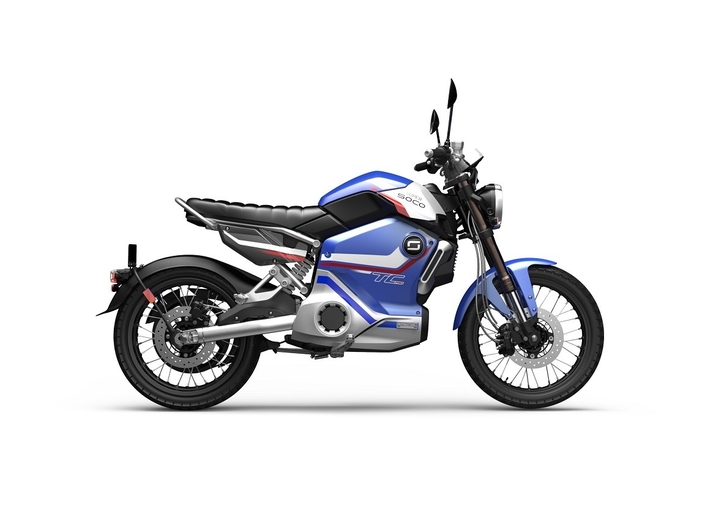
As per the adage from the gold-rush era, the surest winners in a mining boom tend to be the vendors of the picks and shovels, rather than the hopeful diggers and miners, and a similar pattern was in evidence during the great pandemic delivery boom of France. The richest bounty flowed not through to those in the delivery game, but for those who supplied the sets of wheels the delivery agents relied on to shuttle meals down rues and boulevards.
The e-bike would continue ever onward in its upward march, extending its decade-long ascent in 2020. The year would be acclaimed as La belle année du vélo électrique by one publication, (75) and for e-bike retailers across the country it was indeed a beautiful year, with the number of units sold in France capping the 500,000 mark for the first time. All the more impressive, considering that most of the population was trapped indoors for months.
However, while the VAE continued its power-assisted uphill climb, a new class of machine was coming into its own, its rise helped along by a series of unfortunate events over an unfortunate year.
As early as 2019, Deliveroo had started to goad their riders to upgrade their wheels, and many did, initially to petrol scooters. But the route they were following was an orbital, and whichever way they followed would sooner or later run into the autoroute electric.
When covid-crisis hit, it ultimately accelerated the trend that had been kindled by Deliveroo the previous year. As more and more riders flooded the streets, riders were caught in a dog-eat-dog race for survival, with only those with the speediest set of wheels able to last the distance. E-bike riders found themselves increasingly left in the dust.
Almost as if a fast-forward button had been hit, the months of crisis offered up a snap-shot of the future. But the glimpse it offered was a dystopian vision, one in which scores of fume-belching, kamikaze scooters had taken over the inner-cities of France, and many French citizens didn’t relish what they saw.
The months of lockdowns thus served as a real-time demonstration that the dream of a future of home-delivered food wasn’t going to be achieved with fleets howling petrol-guzzlers. It was clear that the delivery rider of tomorrow would ride electric.
Electric motorcycles are handicapped by two notable liabilities that limit their mainstream appeal, the first being the restricted autonomy compared to their oil-thirsty counterparts, the second being the extended wait required to recharge a battery. As a rider ventures beyond suburbia, range anxiety tends to kick in, the bikers confidence draining as the klicks tick by.
Even so, the electric motorcycle was no poor cousin of the family, for in one role the electric motorcycle was the reigning queen. Serving as a courier bike, it was the vehicle par excellence.
For the food delivery autoentrepreneur, responsible for all the on-the-job overheads, swapping a gas-guzzler to an electric model was a no-brainer. The cost of a full recharge of an electric scooter was 0.20 euros, compared to 10 euros for a full tank of petrol. The difference ended up in the pocket of the rider at the end of the week. (76)
But not only did the electric motorcycle option work for the rider, it also won over the restaurateur, as the inoffensive low-decibel motor helped keep the neighbours on side, while leaving the ear-drums of the patrons un-split.
The pandemic delivery boom in France put the electric motorcycle segment in the spotlight.
The demand for these machines soared over the pandemic, and independent food delivery couriers were at the core of this.
In the first three months of 2021, electric scooter sales in France jumped by 21.6% compared to the same period of the previous year, and by 19% against the same quarter of 2019, the last ‘normal’ year. (77)
Notably, these months coincided with the crack-down by the cities of Montpellier and Nantes, with delivery riders on conventional scooters hounded out of the city-centres, but a hall-pass offered for riders on electric models.
But this was the continuation of a trend that had been underway for several months. By the end of 2020, the electric motorcycle had become a common sight on French streets, with two brands dominating. The first, the small and emerging Super Soco, and the second, a rising Chinese juggernaut, Niu Technologies. Chasing at their heels of these two, and also worthy of mention, was a native start-up called Red Electric
The graphic below highlights the registration numbers recorded in France for these three brands in the year 2020. Super Soco pipped the post, coming from nowhere to beat Niu, who were top banana the previous year, (78) though Niu were to enjoy a strong rebound in early 2021. (79)
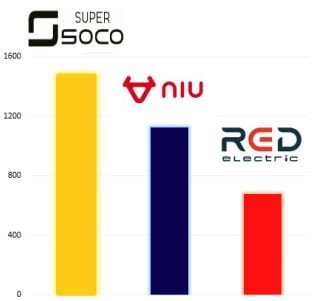
Super Soco, Niu and Red Electric
Only one vowel removed from the better known Chinese Electric Vehicle company and rival to Tesla, Nio, the Nasdaq-listed Niu may be more interesting than its larger name-lookalike, attracting a noteworthy investor in Ark Investment Management, who were regular buyers of stock over 2021. (81)
Niu’s international operations were disrupted by the pandemic in the first part of 2020, but by the start of the following year they had made significant inroads into the French market, riding the coattails of the boom in food delivery.
That year, Niu enjoyed a fillip when it entered into a partnership with the French branch of Domino’s Pizza, aimed at electrifying their fleet of delivery vehicles spread about the hundreds of franchises of the group around the country. (82)
The deal with Domino’s restored Niu to top place in the electric motorcycle segment in the first half of 2021, and the Chinese company was also the 7th most popular motorcycle brand in France overall in early 2021. (83)
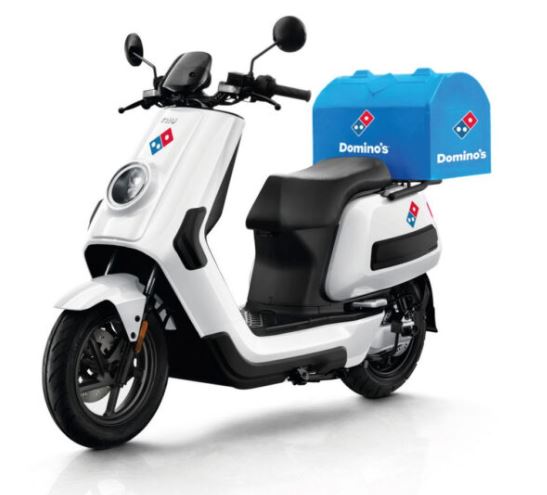
While Niu is purely a Chinese EV play, its upstart rival Super Soco requires a little more elucidation. Sometimes mistakenly presumed to be Chinese in the European press, and almost as often as Australian, in reality it is something of a hybrid, falling under the umbrella of a parent company, Vmoto Soco, the product of a joint venture between companies from the two countries in 2020.
Super Soco Intelligent Technology is a hi-tech EV company that emerged in the Chinese mega-city of Shanghai in 2015 on the back of a crowd-funding drive. (84) The hit Super Soco brand was the brainchild of the eponymous Shanghai group.
The Australian partner, Perth based Vmoto, was an early-mover in the electric two-wheeler space, cutting the ribbon on a fully operational two-wheeler manufacturing plant in Nanjing in 2009. (85)
In 2020, Vmoto and Super Soco formed a joint venture under the name of Vmoto Soco, serving as a vehicle through which Vmoto had the rights to distribute Super Soco’s motorcycles across international markets. Vmoto Soco also became the exclusive manufacturer of the Super Soco motorcycle range. Super Soco continued to operate as an independent company, but focused on the Chinese market
Today, the assembly lines of the group’s Nanjing plant today churn out a procession of Super Socos, as well as Vmoto’s own brand of fleet scooters, the latter being a no-frills model of delivery scooter catering to bulk orders in the delivery segment. Vmoto dreams of imparting some premium-cachet to the brand, with plans to release a line of high-end e-motorcycles under the same name. (86)
France proved to be one of the most fertile markets in Europe for the Vmoto Soco group, with the local dealer network growing from 25 in 2017 to over 200 in 2020. While Niu dominated the electric scooter field in France, Super Soco was favourite in the electric motorcycle space, with the Super Soco TC model the top selling e-motorcycle in France over 2020.
Red Electric, the nascent local player is smaller than either Niu or Vmoto Soco, but it is worthy of comment, not least because the Red speciality is the electric delivery segment.
Key to Red’s strong performance in the pandemic-year was a timely arrangement the company entered into with Deliveroo in the early days of the pandemic, aimed at providing Deliveroo’s riders with discounted rental scooters. (87)
The strong performance of this six-year old French start-up again points to the delivery boom as being the most meaningful driver of electric motorcycle sales in France over the woebegone years of 2020 and 2021.
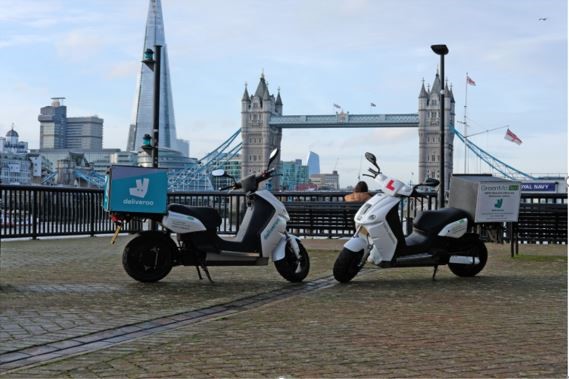
Conclusion: The Revolution will not be televised
And so it was that in the turbulent year of 2020, a food revolution would unfold in the land of haute-cuisine. Never before had the French ordered so many home delivered meals. Once unthinkable scenes, such as gourmet meals being ferried across towns in brown paper bags, became routine.
It was not a trend that was universally appreciated. The users of food-delivery apps were widely reviled, impugned online with a litany of insults such as ‘exploiters of the vulnerable‘, ‘Netflix-addicted couch potatoes‘ and worst of all, ‘don’t know how to cook.’ But obviously, someone was using them.
While the instigator of change was an invisible pathogen, the hand of change was an army. But it was an unusual army, assembled not by a nation-state but by one of two food-tech multinationals who dominated the foodscape of France.
Napoleon reputedly stated that an army marched on its stomach, but this army was one that marched on the rumbles of the stomachs of others. Hunger moves the world, and the hunger-pangs of a multitude exerts more tug over the course of history than even the wealthiest of billionaires.
Almost exactly fifty years ago, the poet and musician Gil Scott-Heron coined the phrase ‘The revolution will not be televised.’ Today, with almost everyone walking around with a tiny screen in their pocket, the words may be more poignant than even in Scott-Heron’s time.
Where this is in evidence more than anywhere else today is in the EV space, where a Mars-dreaming celebrity CEO has captivated the cameras, masterfully mesmerising the media in order to promote himself and his company, Tesla, as the solution to the challenge of transport emissions. So successful was he at imprinting his stamp on the emerging industry, that the term ‘Electric Vehicle’ has largely become synonymous with ‘electric cars’.
And yet, the most common electric vehicle in the world today is not the electric car. It is the electric bike, and by a wide margin.
We need look no further than our case study, France, to demonstrate the point. In the pivotal year of 2020, the number of e-bikes sold in the country in just that one year exceeded the number of electric cars sold over the preceding decade. (88)
There is an inkling here as to what Gil Scott-Heron was getting at with his signature phrase. A revolution largely goes unnoticed, proceeding quietly in the everyday. It unlikely to take the form of a celebrity billionaire, whose image and message is relentlessly beamed over oceans onto living room TVs and hand-held devices throughout the globe, more likely, it is out the window, in the form of a delivery rider on an e-bike quietly gliding past.
The first electric vehicle revolution of the early 21st century was not driven by the celebrated Tesla and its photogenic CEO, it was driven by delivery platforms such as Deliveroo and Uber Eats, companies which most people detest, and a legion of delivery riders, so anonymous that they seldom appear in the advertisements of the companies who they work for.
There are few countries where the Deliveroo-Uber Eats duo would be less on the nose than in France, where the two companies often serve as ritual piñatas for the local press, perceived as manifestations of the widely loathed societal shift towards l’ubérisation.
And yet, businesses that are more the du jour of the local media, home-grown players such as Velyvelo and Teebike, are themselves indirect beneficiaries of the same trend, riding the wave that was created when the major delivery platforms took the plunge into the French market in the middle of the 2010s.
The constant churn of independent delivery riders working through the platforms created a market for these start-ups, the regular drip of new customers nourishing the e-bike ecosystem and encouraging plucky new players to take the leap.
The electric revolution shifted to a new phase in 2020, though once again driven by the same sparring protagonists. The warring food-tech giants who had built up armies of freelancers from the ground up were now demanding that their e-bike riding agents level up. The change came right from the top, dictated by algorithm.
Underpinning the algorithm’s volte-face was a pivot in the strategic direction of the contest for France. The holy-grail of oligopolisation required the platforms to venture beyond the low-hanging fruit of densely-populated métropoles, to the regional centres where the majority of the French population resided. These smaller cities were characterised by horizontal urbanisation, terrain on which the traditional food delivery work-horse, the e-bike, was ill-suited. But the algorithms proposed alternative, the petrol-scooter, proved to be a dead-end.
Nantes represents an illustrative test-case in miniature as to how this shift was to play out, not least because most of the Delivery riders here worked for the platform that had been the most aggressive in promoting the shift from muscle to motors.
The spark for the later flare-up in the town had been kindled in 2019, when Deliveroo’s in-house algorithm, Frank, started to load the dice to the benefit of the local scooteriste. Livreurs on e-bikes watched on glumly as their colleagues on motor scooters monopolised the order flow. But the pandemic driven boom of 2020 would push the trend into overdrive, the ranks of the delivery riders swelling in line with the bellies of the locked-down residents.
In Nantes, Deliveroo was to realise their folly. An army of scooter riding livreurs makes for an infernal din, as the residents of central Nantes were to discover in the lockdowns. Deliveroo had overlooked the degree to which their early successes had been riding on the back of the unobtrusive e-bike.
The noisome scooter flew in the face of the Deliveroo dream of regularising meal delivery. The Nantes council offered a clue as to the way forward by exempting electric scooters from the movement restrictions.
Motorcycle dealerships around Nantes ended up doing a brisk trade in electric two-wheelers in the wake of the controversy in the piétonne. In the wash up, the Deliveroo algorithm Frank had inadvertently ended up driving sales for the likes of Niu and Super Soco, whose scooters would have no doubt been selling at a rapid clip in motorcycle dealerships in the area. (89) But as is clear from the nationwide registration numbers for electric motorcycles, the trend was broad-based.
In the midst of a grim year, a quiet insurgency was underway down the city boulevards and country lanes of France. Despite the insidious shadow of the virus- or perhaps because of it- sales of deux-roues went through the roof. Spurred on by algorithm-governed platforms, with lockdowns providing the ignition spark, a food revolution would propel the e-motorcycle into the mainstream. As with the e-bike a decade before, it was the legion of delivery couriers who served as the spearhead of this new electric putsch.
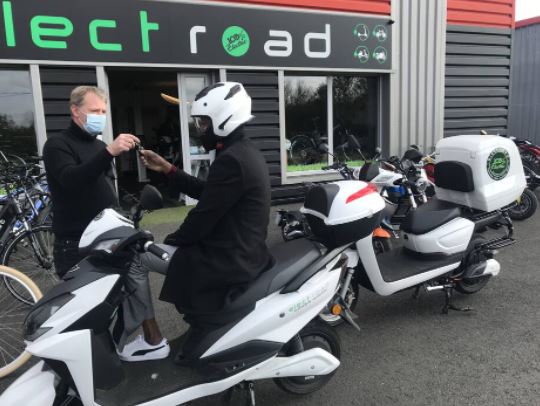
Footnotes
(1) View Source
(2) View Source
(3) View Source
(4) View Source
(5) View Source
(6) View Source
(7) View Source
(8) View Source
(9) View Source
(10) View Source
(11) View Source
(12) View Source
(13) View Source
(14) View Source
(15) View Source
(16) View Source
(17) View Source
(18) View Source
(19) Ibid.
(20) View Source
(21) Ibid.
(22) View Source
(23) View Source
(24) View Source
(25) View Source
(26) View Source
(27) View Source
(28) Ibid.
(29) View Source
(30) View Source
(31) View Source
(32) View Source
(33) View Source
(34) View Source
(35) View Source
(36) View Source
(37) View Source
(38) View Source
(39) View Source
(40) View Source
(41) View Source
(42) View Source
(43) View Source
(44) View Source
(45) View Source
(46) View Source
(47) View Source
(48) View Source
(49) View Source
(50) View Source
(51) View Source
(52) View Source
(53) View Source
(54) View Source
(55) Ibid.
(56) View Source
(57) View Source
(58) View Source
(59) View Source
(60) View Source
(61) View Source
(62) View Source
(63) View Source
(64) View Source
(65) View Source
(66) Deliveroo prospectus, (View Source)
(67) Deliveroo prospectus, pg 63 (View Source)
(68) Based on 2019 United Nations population data
(69) View Source
(70) View Source
(71) View Source
(72) Gross Transactional Value = the total value paid by consumers, not including tips. Deliveroo Prospectus pg 75 (View Source)
(73) View Source
(74) View Source
(75) View Source
(76) View Source
(77) View Source
(78) View Source
(79) View Source
(80) View Source
(81) View Source
(82) View Source
(83) View Source
(84) View Source
(85) Vmoto announcement, ‘Vmoto takes full control of Chinese manufacturing’ 05/10/2009
(86) View Source
(87) View Source
(88) In France in the year 2020, over 500,000 e-bikes were sold (source). The total number of electric cars registered over the decade 2010-2020 was 344,742 (source)
(89) View Source

